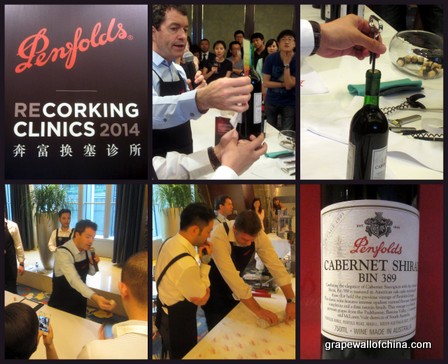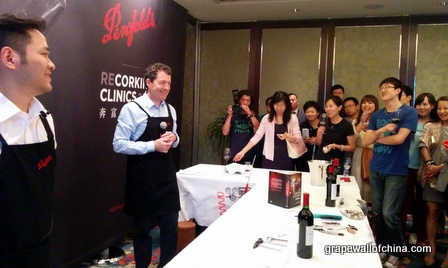Australian wine producer Penfolds today held its first re-corking clinic in Beijing, with several sessions organized by importer / distributor ASC at China World Summit Wing. As Penfolds’ website puts it:
The Penfolds Re-corking Clinics offer the owners of Penfolds red wines which are 15 years and older the opportunity to have their wines assessed by a winemaker, and if necessary, opened, tasted, topped up and re-capsuled on the spot.
Chief winemaker Peter Gago said 120,000 bottles have been re-corked over the past 23 years. Today’s clinic included bottles of icon label Grange from 1955 and 1971.
Gago demonstrated re-corking to a group of about 40 of us by using a 1993 ‘Bin 389’ Cabernet-Shiraz.
The process includes using a color-coded gauge to assess the level of wine in the bottle (see photo below). Once the decision is made to open the bottle, the cork is pulled and gas immediately inserted into the neck to preserve the wine. A sample of about 15 ml is removed and tasted, with wine from the newest vintage then added as a replacement. Gago said the amount involved — about 2 percent of total volume — does not affect the wine’s integrity but that re-corking is only allowed once. The bottle then gets a new cork and capsule, and is wrapped in white tissue paper, which he said is useful as it easily shows leaks.
A few other comments by Gago:
- While people might automatically reach for the most common openers, such as ‘the waiter’s friend‘, Gago said older corks tend to be more fragile and require tools that are gentler.
- Gago also said recommendations on “drink by” dates tend to be based on ideal storage conditions. “A big issue with wine is movement. In England, a bottle of Cheval Blanc might have changed hands 18 times but never left [the cellar],” he explained. In contrast, another bottle might have been shipped around the world numerous times and thus have less aging potential.
- And he said the clinics are also useful for those who want to make sure they have the real Penfolds deal. “They are not just re-corking clinics, they are also authenticity clinics,” said Gago.
Finally, Gago cited an “ulterior motive” for the clinics, namely, “to take bad wines out of the system.” He says that when an assessment “finds something isn’t as it should be”, the bottle gets a white dot, which is essentially a recommendation to drink or discard the wine. For some owners, this almost seems like a blessing:  “Sometimes people like it because they’re getting permission to drink the wine right away.”

Grape Wall has no sponsors of advertisers: if you find the content and projects like World Marselan Day worthwhile, please help cover the costs via PayPal, WeChat or Alipay.
Sign up for the free Grape Wall newsletter here. Follow Grape Wall on LinkedIn, Instagram, Facebook and Twitter. And contact Grape Wall via grapewallofchina (at) gmail.com.


Leave a Reply
You must be logged in to post a comment.